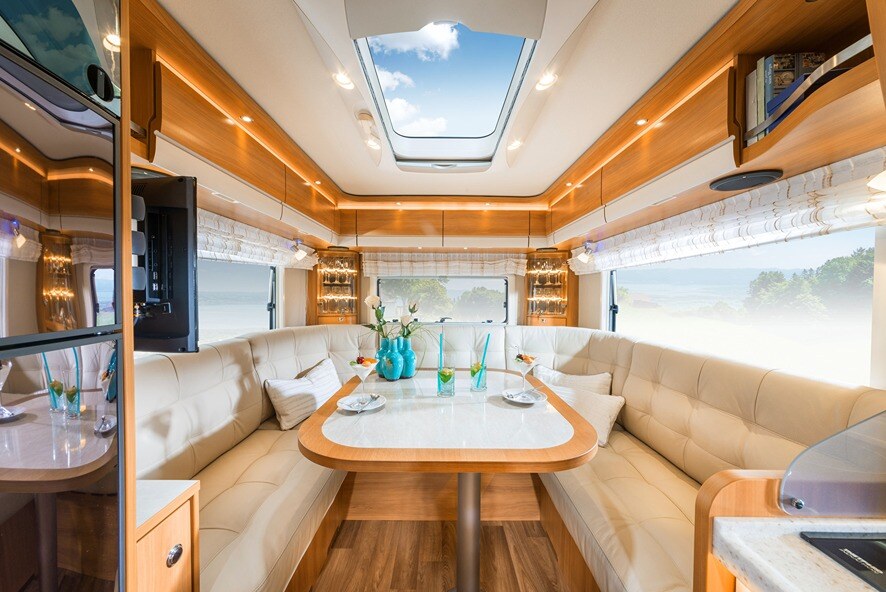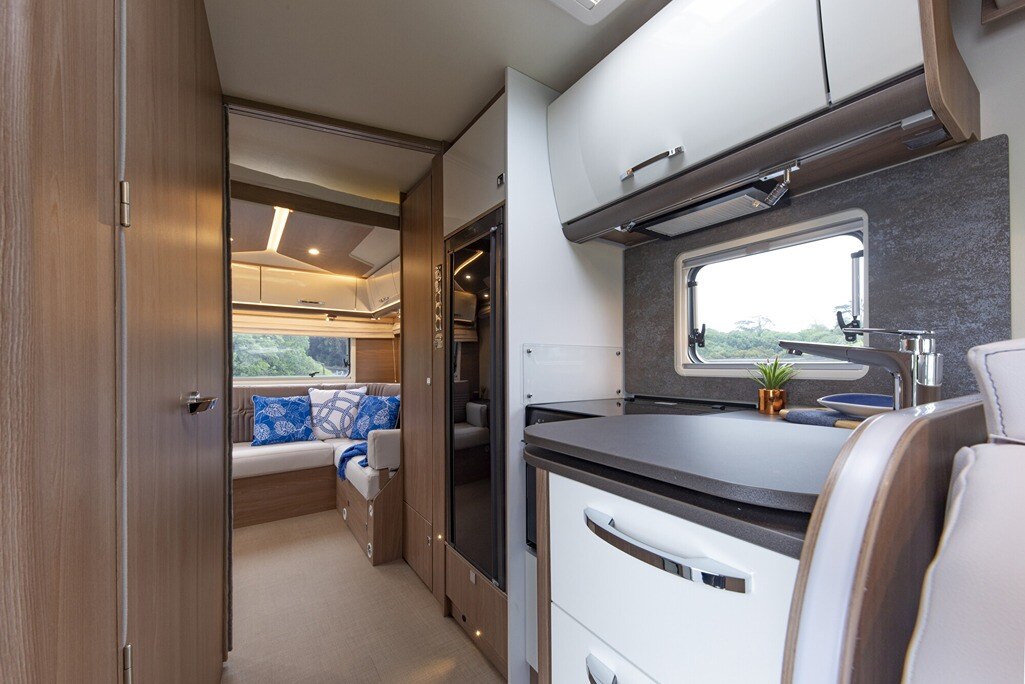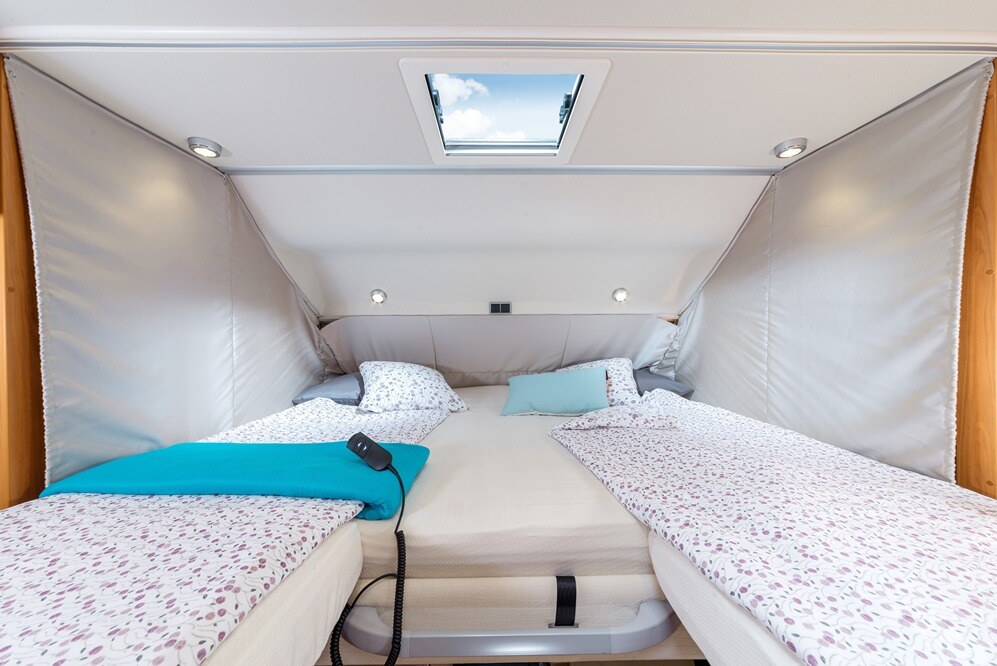If you’re planning to spend a decent amount on a new motorhome, you’ll have the pick of two types of body construction.
In the more affordable corner is the semi-integrated motorhome — which still retains the front sheet metal parts and cab components of its donor van that provided the platform.

While over in the money’s-no-object corner is the fully integrated motorhome — where all the body parts of the van have been replaced by the motorhome builder’s own bespoke components.
Which one’s best for you — the 75 percent step or the full 100 percent body reconstruction?

|
Motorhome types and classes
|
Semi-integrated motorhomes
The most popular recreational vehicle among New Zealand buyers is the semi-integrated motorhome.
The semi-integrated motorhome's starting point is the van cab chassis, which enables several cost savings that make it more affordable. This method of body construction's popularity is due to its ability to meet the purchase budgets of many new motorhome buyers.
Semi-integrated motorhomes retain the front steel cab of the light commercial van that donated the platform and blend it into a fabricated body. This body is usually constructed of an aluminium tube frame clad with composite interior and exterior cladding — with a bonded layer of insulation between them.
When deciding whether a semi-integrated motorhome is your ideal type of RV, consider some key differences.
Retaining the cab
With the cab of the motorhome’s platform retained, the manufacturer doesn’t have to reconfigure the wiring loom of the donor van to operate the headlights, indicators and windscreen wipers. Nor does the van’s heating, ventilation and air conditioning system need a complete rebuild, as the existing system can be retained along with the rest of the cab’s original equipment.
That includes the side doors of the cab — one of the highest ticket items in automotive body construction. When designing a new model of any motor vehicle, a manufacturer will often retain the doors of the previous model. This is because the cost of tooling up to build new ones is considered prohibitive.
Therefore, retaining the donor van’s doors represents one of the biggest cost savings semi-integrated motorhomes offer over their fully integrated cousins.

Find out more about the different sizes and types of motorhomes in NZ.
Steel or aluminium frame
More expensive semi-integrated models are likely to have hybrid chassis. In this case, an aluminium frame has been added to the cab’s original front steel structure and front suspension — to carry the motorhome’s living quarters.
Using aluminium instead of steel for the rear two-thirds of the chassis saves significant weight. The added rear section of the chassis often rides lower than the original van structure, creating extra room inside the cabin.
Building the chassis in this way creates two opportunities for motorhome manufacturers, leading to the next point of difference in semi-integrated models — whether they have one or two floors.
The double floor
Motorhome manufacturers can use the front steel-rear aluminium chassis to:
- Lower the cabin’s floor level — to allow more generous floor-to-ceiling dimensions and easier access via the side door, or
- Fit a double floor — which enables neater tank-battery storage, increased insulation, better winterproofing and lower cabin noise levels on the road.
An added bonus of the double floor is that the upper level is usually the same height as the cab floor. This eliminates the trip hazard of the step up to the rear bedroom that occasionally results in stubbed toes when moving about the habitation unit.
A strong foundation
Semi-integrated motorhomes that retain all underpinnings of the original van chassis have major advantages, such as:
- Riding how the van manufacturer intended
- Creating arguably a stronger foundation for motorhomes subjected to New Zealand driving conditions.
Affordability
The semi-integrated motorhome is the middle ground between the campervan and the fully integrated motorhome — which has all the bodywork of the donor van replaced.
Semi-integrated motorhomes are significantly more affordable than integrated ones. They also offer just as much usable cabin space, and the driving cockpit isn’t quite as intimidating because it’s the same as the donor van.
If you buy a semi-integrated motorhome, ensure that the front cab seats can swivel 180 degrees to face the cabin while you’re parked up. Some light commercial van makers only build fixed seats into their vehicles.
|
The marriage of a van front-end with a fabricated cabin is a well-proven formula for creating practical, spacious and affordable motorhomes. It’s a big positive for semi-integrated types.
On the negative side, some manufacturers are better at integrating the cabin with the van than others. As a driver, you’ll also have a narrower point of visual reference due to the habitation area being wider than the cab — making it harder to manoeuvre and judge distances.
Paul Owen — Award-winning motoring journalist |
Find out more about the construction of semi-integrated motorhomes.
Integrated motorhomes
When a motorhome manufacturer discards all the steel bodywork of the donor van platform in favour of an entirely fabricated new structure, it builds a fully integrated motorhome. The driver’s cab is integrated into the habitation unit — with no barrier in between. It’s purpose-built to be a motorhome rather than converted from another vehicle.
Integrated motorhomes generally cost around $50K more than semi-integrated equivalents of a similar length, number of berths, fit-out and equipment.
Instead of beginning with a readily available van cab chassis, the fully integrated version results from the arrival of a naked modified chassis at the motorhome maker’s production facility. The original donor van’s powertrain, electronics, front seats, steering system and dashboard architecture are retained.
Usually, this stripped chassis is modified by AL-KO and retains the original structural front members of the van. However, the front suspension is replaced with AL-KO components — either air or steel springs.
The rest of the chassis will be all AL-KO’s work with:
- Honey-combed chassis rails — for reduced mass
- Rear suspension tuned to the final gross vehicle mass of the completed motorhome — otherwise known as the GVM or unladen weight plus payload.
|
What is AL-KO? The AL-KO Vehicle Technology Group is the world leader in high-quality chassis and suspension components for leisure vehicles. They represent the best in functionality, maximum comfort and innovation — to ensure greater driving safety. |

Modifications are made
The first step in the construction of a fully-integrated motorhome is the modification of all the retained in-cab systems for their use in the wider cab. Then, when the dual floors, furniture, electrics, gas lines and plumbing have been mounted to the chassis, the assembly of the fully integrated body begins.
On the driver’s side is an entire wall that’s been machined with cut-outs for a cabin side entry door, windows, rear garage and other lockers. It’s the same on the other side — the single body panel is machined to also allow fitment of a door adjacent to the front passenger seat.
The roof is added, along with the front mask and rear panel — all typically protected by a single-piece glass reinforced plastic (GRP) outer layer.
A spacious cab
The rear living space will likely be identical to a semi-integrated sibling model. However, an integrated motorhome may feel more spacious with extra storage up front in the cab.
The more seamless look of the fully integrated motorhome is perhaps the best reason to consider buying one — these models are the show queens of any campground.
The front windscreen
Another big selling point is the huge front windscreen. If you think a van windscreen offers a panoramic view of the oncoming scenery, a fully integrated model enlarges that view by 30 percent.
However, there are some downsides to buying a fully integrated motorhome than just the extra cost.
Variable number of doors
Unlike semi-integrated motorhomes, which have three doors, integrated RVs tend to have fewer. In Europe, it’s common for integrated motorhomes to have a single habitation door — and you’ll find the same scenario with most fully integrated ones in NZ.
This body style creates inconvenience and can become a safety issue in an accident or fire.
Replacement difficulties
That large bespoke front windscreen is incredible to look through, but it’s hard to replace in a hurry when damaged.
Front panel damage on an integrated motorhome is more expensive to repair as it has a large mask — a one-piece made of composite materials that may completely need to be replaced.
This means that the front panel isn't just a separate piece — it's often a structural part of the whole front of the RV. Therefore, damage can affect a larger area and potentially impact the motorhome’s structural integrity. This can also be the case with rear damage to an integrated motorhome.
Contrastingly, a semi-integrated motorhome has several pieces in the front or rear section, making it much easier to repair.
|
The advantages of fully integrated motorhomes are the tidier design aesthetic, huge windscreen view and cab width — which matches the rest of the motorhome.
When it comes to disadvantages, it’s the most expensive motorhome body style, you usually lose an exit door and it can be complicated to replace the windscreen and wiper blades.
Paul Owen |
Quality control is critical
The process of bringing these massive body parts together is a complicated one. Care must be taken to ensure complete accuracy and that no wires or pipes attending the electric, gas and plumbing circuits are compromised.
Makers of fully integrated motorhomes invest heavily in quality control processes to ensure that their well-heeled customer base is completely satisfied — and that body assembly is precisely measured and verified. The result is a neater, better-looking body that oozes quality.
The only joins likely to be seen in a fully integrated motorhome body are where the wheel guards and underbody protection strips have been added to the side walls.
Contrast this with a semi-integrated version where the joining of the original van cab to the wider motorhome cabin results in several extra panel joins.
From high-end to entry-level
The fully integrated motorhome used to be synonymous with luxury. It was larger, more highly specced, and came with lavish fabrics and finishes — plus it was fitted out with more high-end equipment than semi-integrated models. And because it used to be built on a heavier chassis, it was able to carry more weight.

Today, integrated motorhomes aren't restricted to high-end models. Many entry-level brands have taken the layout of their semi-integrated model and simply built it with a fully integrated body.
Although the specs and fitout are still similar to their semi-integrated cousins, these entry-level integrated models have the advantage of a more spacious front living area. They usually also have less than 3,500kg in GVM — meaning they can be driven on a car licence under a warrant of fitness (WOF). But they don’t come with luxury.
If you’re seriously considering an integrated motorhome, it’s important to inspect the engine bay to ensure the filler caps for engine oil, windscreen washing fluid and engine coolant remain accessible.
Find out more about the types of motorhomes available in New Zealand.
Living in a semi-integrated motorhome
At the more expensive end of the semi-integrated sector, you’ll find motorhomes with dual or double floors just like their full body alternatives. These generally result in flat floor levels all the way from cab to garage.

However, cheaper semi-integrated models that use a single floor tend to place the flooring on several different levels — resulting in steps that might catch you out. These cheaper models often:
- Have higher cabin noise levels when you’re on the move
- Aren’t as well insulated against the weather.
Space
The cabin width dimensions of semi-integrated motorhomes are usually wider than those of the van cab up the front. As a result, there isn’t all that much spatial difference between the two body styles when it comes to the living room.
The difference is mostly noticed up front where a fully-integrated body will offer more room, especially overhead.
Maximum garage luggage mass is commonly rated at around 250kg for a semi-integrated body. Many fully-integrated motorhome models can cart 450kg back there — due to their more extensive chassis and suspension improvements.
See our guide on maximising storage space in your motorhome.

Living in an integrated motorhome
The neat exterior design of an integrated motorhome normally translates to a tidy-looking design on the inside with:
- More linear lines of sight
- Slightly more floor and ceiling space — especially up front.
This means that any drop down beds located above the front lounge can be better integrated into the interior roof line and will give you extra headroom. They’re usually situated a little further forward in an integrated motorhome compared to a semi-integrated model — making your lounge feel more spacious at night.
The driving area of an integrated motorhome can also be better utilised when parking up for the night. Cab blinds are simple to open and close thanks to the spacious headroom. They can often be deployed at the push of a button.

Integrated cabins are usually a little wider than semi-integrated ones. This allows for an easier front cabin reconfiguration when putting your motorhome into transit mode. Lounge bench seats can be rotated 45 degrees to provide a couple of forward-facing seats with certified seat belts — due to that extra width.
Find out about seat belt safety in motorhomes.
Driving a semi-integrated motorhome
Semi-integrated motorhomes drive almost exactly like the vans they look like. They have the same side mirrors, same controls and same seats.
It can be easy to forget that there’s a wider cabin following the relatively narrow cab. This only really becomes an issue if you’re trying to avoid adjacent tree branches on narrow rural roads or you’re manoeuvring around a campsite.
The safer choice
It could be argued that a semi-integrated motorhome is a safer choice than an integrated one.
In New Zealand, most integrated motorhomes have three exit doors just like their semi-integrated counterparts. However, you can buy them with only one door in Europe. Should the motorhome catch fire due to some electrical or gas system fault, three exits are better than one.
As for crash test performance, in 2019 the Swedish Transport Authority (Trafikverket) found some interesting results comparing the two body types. A semi-integrated motorhome achieved slightly better results than a fully-integrated model in back-to-back frontal impacts into an offset stationary barrier at 64km an hour.
Driving an integrated motorhome
From the driver’s perspective, you’re aware of the width of an integrated motorhome as there’s a pair of reference points right in front of you — the outer edges of the windscreen. The generous size of the windscreen provides unparalleled views of the scenery you’re driving through.
However, should your fully-integrated motorhome’s windscreen get a stone crack or chip, it may take a while for a repairer to source its more specialised replacement screen.
Contrastingly, the screen of a semi-integrated motorhome can be repaired almost immediately anywhere in New Zealand.
Is it time for a test drive?
Perhaps the best way to decide whether to buy a fully-integrated motorhome or a semi-integrated equivalent is to first rent one of each body style. Aim to find out whether the popularly-perceived advantages of the more expensive fully-integrated version are real — or just the stuff of our collective imagination.
You can make an argument for either body style with safety and reduced costs being the main trump cards of the semi-integrated versions. Whereas design integrity, extra cab space and greater storage are positives of the full-bodied versions.
Download our Ultimate Guide to Test Driving a Motorhome from a Dealership to help you make the most of your trial run and choose the right motorhome for your lifestyle.



